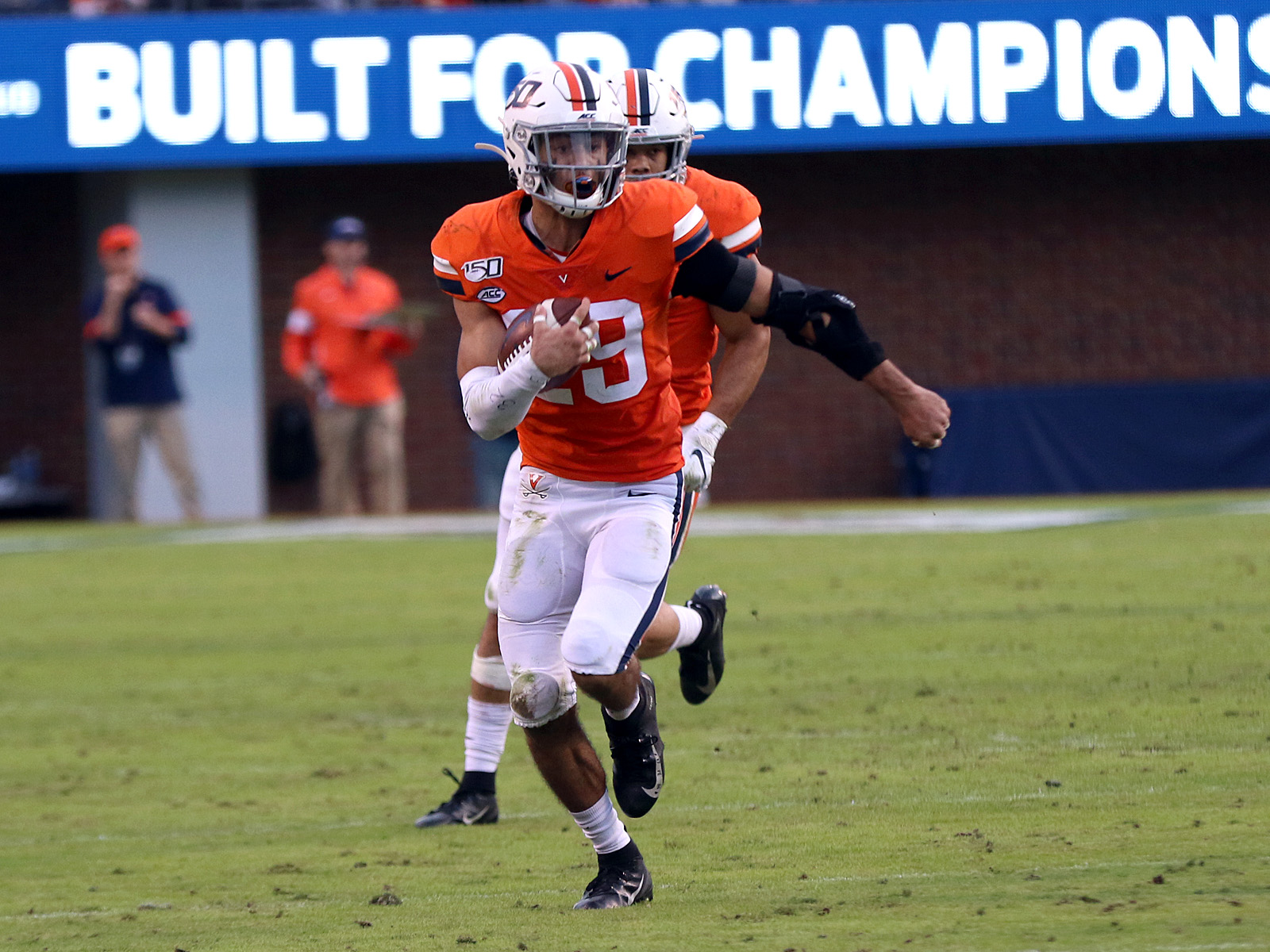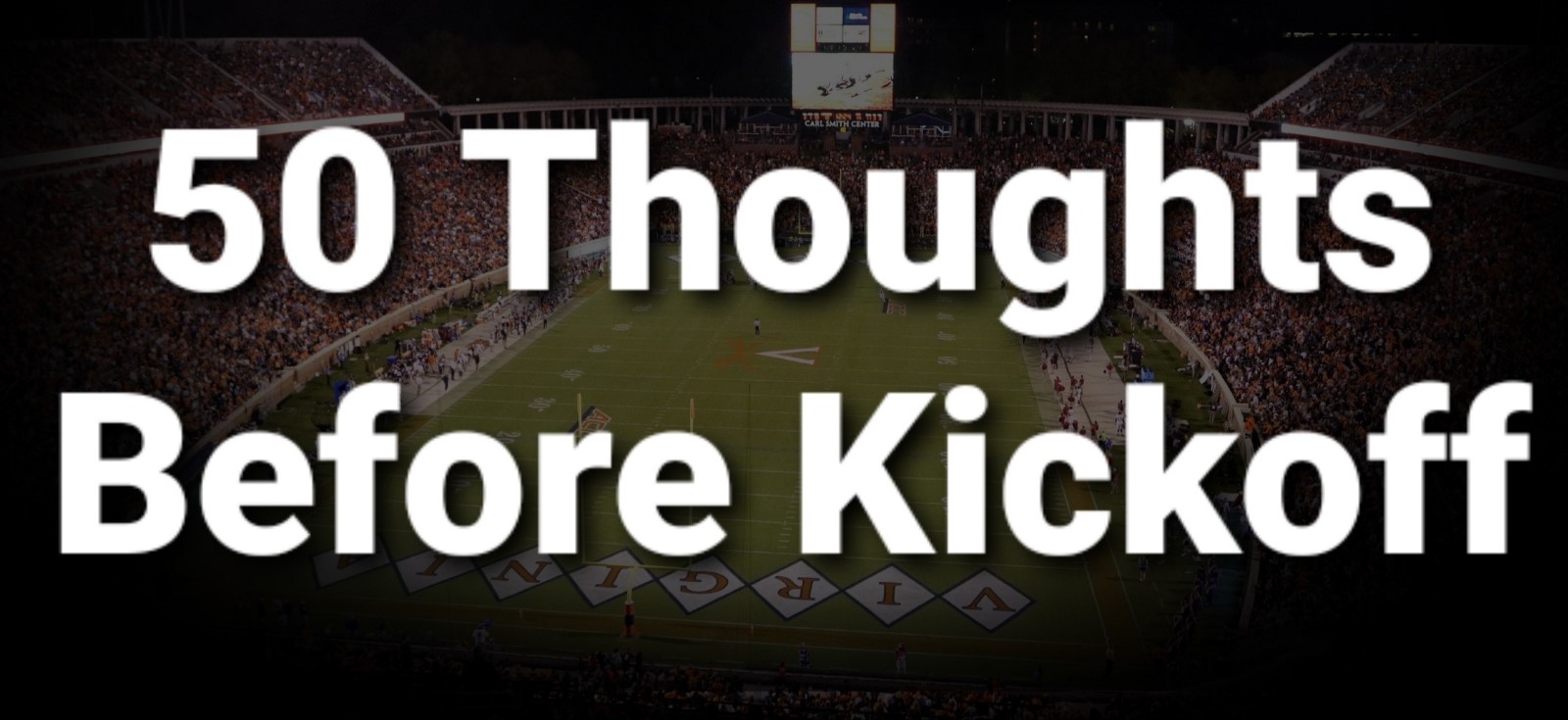
The Virginia football team has arrived to within 24 hours of kickoff for the 2021 season. The Cavaliers are chasing their fourth straight season without a losing record and the fourth bowl bid of the Bronco Mendenhall era. After last season’s division pause, they’ll also try to claim the ACC Coastal Division title for the second time in a row.
 TheSabre.com’s “50 Thoughts Before Virginia Football Kickoff” series has arrived at its final entry – “Big Questions For Virginia Football In 2021.” Let’s review some of the offseason themes on the eve of kickoff.
TheSabre.com’s “50 Thoughts Before Virginia Football Kickoff” series has arrived at its final entry – “Big Questions For Virginia Football In 2021.” Let’s review some of the offseason themes on the eve of kickoff.
Can the Hoos improve their play in the secondary?
Perhaps THE theme of the last nine months. The Cavaliers allowed 304.4 passing yards per game last season to rank 123rd out of 127 teams in the Football Bowl Subdivision. They gave up 19 passing touchdowns, which tied for 94th nationally. They allowed 54 completions of 20 yards or more, which ranked 124th nationally. The struggles led to an offseason coaching shuffle to put more resources in the secondary with Shane Hunter shifting to safeties and Ricky Brumfield taking over the corners. UVA brought in two transfers in Anthony Johnson of Louisville and Josh Hayes on North Dakota State. The coaches also decided to bright back ‘Super Seniors’ Joey Blount, De’Vante Cross, and Nick Grant. For UVA to bounce back from a 5-5 record a year ago, the secondary is going to have to play better.
Is something cooking with the defense?
There has been some chatter this summer that there may be some scheme wrinkles underway on defense as well. After the Spring Game, Mendenhall mentioned the need to play five defensive backs regularly against modern spread offenses. The Cavaliers have done that regularly anyway, but frequently out of a 2-4-5 look with only two defensive linemen. With more experience and depth up front plus the absence of Charles Snowden among the linebackers now, there could be a shift to a 3-3-5 concept. Mendenhall used the 3-3-5 frequently early in his coaching career and in some seasons since.
What will Brennan Armstrong do in year two?
In his first season as UVA’s starting quarterback, Armstrong put together a solid campaign statistically and in the Pro Football Focus grades. He looked particularly sharp during a four-game surge midway through the season, but struggled out of the gates and had interception problems in most of the team’s five losses. He had bouts with inconsistency during many games. Overall, though, there was a lot to build on for a first-time starter and he got a full offseason prep period this time around to follow up lessons learned. With the weapons around him on offense, if he can spread the ball around and add his own rushing ability to the equation selectively, then Armstrong could have a big season in round two as a starter.
Can a veteran offensive line set the tone for the team?
The Cavaliers bring back six linemen with starting experience this season, including five players with double-digit starts in their career. Most observers see this as the best offensive line of the Mendenhall era to date. With a returning starter at quarterback and some weapons at the skill positions, the offense could break into the top 30 nationally in scoring offense if the offensive line lives up to the expectations. Beyond that, the line and by extension the offense can set the tone for the entire team if it is able to win the battle in the trenches game after game. That can lead to an offense that controls the clock when wanted, flips field position even if it’s not a scoring drive, and a defense that stays fresh and aggressive as a result.
Will there be a workhorse or a committee at running back?
With an experienced offensive line, many conversations this season have centered around improving production from the traditional running game, meaning yards and carries from the running backs. The Hoos have four players listed on the season’s first depth chart and Mendenhall said the competition there has been a tight race and basically a photo finish for the listing released Monday. In the past, Mendenhall has voiced his preference for a single back to get most of the carries vs. using multiple backs in the run game. If the running back race has little separation, however, a committee approach might make more sense, especially if UVA is trying to boost the production of the group.
Wayne Taulapapa has the most experience at Virginia, but Mike Hollins, Ronnie Walker Jr., and Devin Darrington all offer possibilities to the unit. It will be interesting to see if multiple players get carries game after game and if the offensive line can get the traditional style run game going regardless of who has the football.
Can Virginia create and win mismatches with Keytaon Thompson and Jelani Woods?
The offense appears to have two special weapons with 6’4″, 210-pound Thompson and 6’7″, 265-pound Woods. A pair of former quarterbacks, that duo has an understanding of how offenses work and a fluid level of athleticism. Thompson flashed what he could do in 2020, moving all around the field and producing. He rushed for 234 yards and 3 touchdowns on 39 carries, an impressive 6.0 yards per carry, and posted 98 yards and 3 touchdowns on 7 catches too. He didn’t join the Hoos until the summer last year after finishing up at Mississippi State before his transfer. Now, the Cavaliers have a better understanding of how to use Thompson and they’ve had an offseason to work on more ways to do it.
Woods didn’t have a huge pass-catching role at Oklahoma State, but the transfer has turned heads since arriving to play in Virginia’s scheme. Tight end Tony Poljan had 6 touchdown catches last season and now Woods steps into that spot, but he offers more versatility for alignments on the field. Murmurs among players in practices this spring and this preseason have talked about just how impressive Woods is from his size to his speed to his hands. It sounds like quite the possible one-two punch against mismatches, but the Wahoos have to go out there and make it work.
Are there big play receiving threats?
One of the big storylines last fall proved to be the emergence of true freshman Lavel Davis Jr. at receiver. He recorded 20 catches for 515 yards and 5 touchdowns, but his size and speed at 6’7″ drew attention even when he wasn’t targeted. Davis finished No. 1 in the ACC and No. 2 in the nation with a 25.75 yards per reception average and those 515 yards were No. 7 nationally among freshmen. Unfortunately, Davis suffered a torn ACL early in spring practice. While his recovery timeline projected a possible late season return, he seemed ahead of schedule late in August per Mendenhall’s comments to the media.
In the meantime, however, the one thing the offense seems to need the most is a big play receiving threat to complement Billy Kemp IV in the short and intermediate part of the field and the hopefully improved running game. Ra’Shaun Henry received positive reports throughout the offseason as possibly that guy and Dontayvion Wicks has earned plenty of offseason ink as he returns from a season-ending injury last fall. If either or both of those players can stretch the field vertically or with yards after the catch, the offense’s potential climbs even more.
Will new specialists be ready and consistent?
Kicker Brian Delaney and punter Nash Griffin finished up their Cavalier careers last fall. That puts two new specialists in the spotlight. Justin Duenkel will get the chance to handle the placekicking duties, while Florida transfer Jacob Finn steps into the punter’s role. Delaney finished his career 42 of 53 on field goals and 110 of 113 on extra points. Duenkel has yet to attempt a collegiate field goal with only an extra point to his credit so far. Finn has considerably more experience. He played in 17 games with the Gators, including all 12 of their games in 2020. He has 28 career punts for an average of 46.2 yards per punt.
Can Virginia make improvement in some specialty situations?
The Cavaliers have not been a consistent team on third down or in the red zone during the Mendenhall era to date. Offensively, UVA has ranked 48th or lower in red zone scoring percentage over the past five years and 74th or lower in third down conversions in three of the five years. It’s a similar story on the other side of the ball. Defensively, the Hoos have ranked 70th or lower in red zone scoring percentage allowed in three of the five years and 79th or lower in third down conversion rate allowed in three of the five years. These categories don’t necessarily break a team’s back if there are struggles, but they can be critical in close games and the ACC Coastal Division is full of toss-up contests.
Beat Tech?
Of all the things to dissect, talk about, and follow with the Virginia football program, one question remains at the front of many fans’ minds. Can Virginia beat Virginia Tech? The Hoos broke a 15-year losing streak in the series in 2019, but the Hokies took back the Commonwealth Cup last season. Tech has won 20 of the last 22 meetings overall. The program is aware of the importance of this game, putting reminders of it up in the football facility and breaking post-practice huddles frequently with a ‘Beat Tech!’ mantra.
While “just getting started” is part of the marketing lingo with UVA’s program currently, many fans won’t buy in fully without more success against the in-state rivals. There’s too much emotional investment to end the season on a sour note so often. That means everything from donations for the revamped Master Plan to season ticket sales to sustained fan enthusiasm are tied up, in part, with that one game. So, yes, that’s a big question: Beat Tech?



